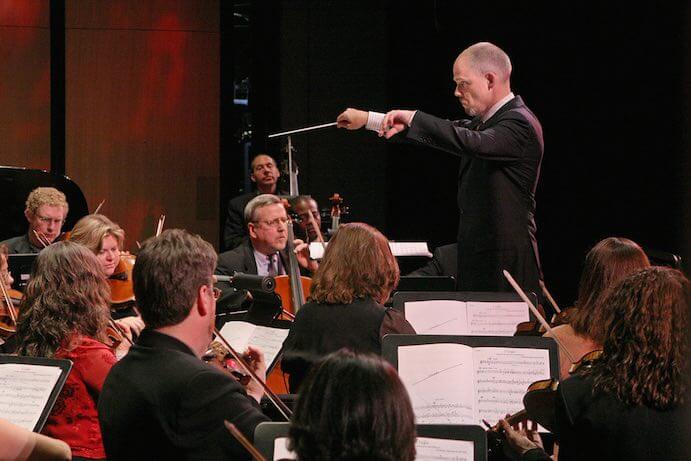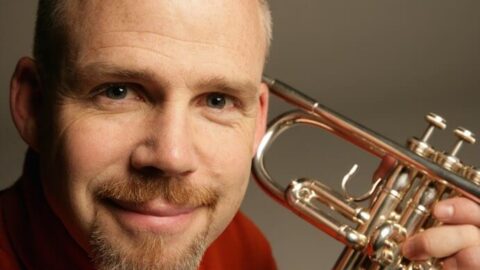Conductor, trumpet virtuoso, and composer Stephen Burns is the Artistic Director of the Fulcrum Point New Music Project in Chicago. He has been acclaimed on four continents for his consistently and widely varied performances encompassing recitals, orchestral appearances, chamber ensemble engagements, and innovative multi-media presentations involving video, dance theatre, and sculpture. I recently saw Fulcrum Point New Music at the Ear Taxi Festival in Chicago, and upon hearing about their upcoming ‘Black Composers Speak’ concerts, I was excited to learn more.
I believe you’re originally from Massachusetts, and were an East Coast musician through your formative years, including training at Juilliard and Tanglewood. What took you to Chicago, and what has kept you there for so much of your career in New Music?
I’m Boston born, inspired at Tanglewood, trained at Juilliard, and polished in Paris. I jumped into the chamber music, new music, and interdisciplinary scene while I was still in school. In the 80’s New York uptown didn’t respect downtown, so you had to choose, so I chose both; Wourinen and Wolpe with the Lincoln Center crowd, Glass, Reich, and La Monte Young with the Tribeca artists, Stockhausen and Boulez in Europe. I moved to the Midwest to teach at IU in Bloomington, Indiana in the mid-90s. In 1997 I was invited to be an artist in residence—a curator of contemporary music—by Performing Arts Chicago (PAC). My wife is from Chicago so it was a natural fit. We’ve lived here since ’99.
When you arrived in Chicago, the new music scene could (generously?) have been described as ‘thin’. What led you found the Fulcrum Point New Music Project, and what were the early years like?
The reason this position came about was because PAC presented all kinds of cutting edge music, dance, theater, film, and puppetry, but the new music scene needed a breath of fresh air, a shot in the arm, and some shaking up. It’s not that the scene was thin, but that it was narrowly proscribed. When you have Pierre Boulez and Ralph Shapey anchoring your new music scene, you can’t really say it’s thin. But they were giants who threw enormous shade (in every sense of the word) so minimalists, neo-classicist, neo-romantics, post-modernists, and multimedia artists didn’t get the support and recognition they needed; so, none of them moved here.
PAC gave me a mandate to create dynamic new programming with a broader range of styles, multimedia content, and social events. We had concert dance parties of new music inspired by Jazz, Funk, Blues, Rock and Latin, followed by party music played by a DJ or band with dancing, food, and drinks. We started our Peace Concerts as a result of interfaith initiatives and anti-war rallies. Special events with architects, artists, film, photography, poetry, and site specific performances made each concert an event. We were the first to use theatrical lighting at our concerts, host post concert receptions matching food with music, and have programs of what I call New Art Music: a mix of minimalism with serialism, John Cage and George Crumb with Zappa and Fela. Jazz, Fluxus, Free Improv, hybrid fusions of Indian, Chinese, Balinese, Latin, Arab, Persian, and other traditional music filled the vacuum created by the great Modernist powerhouses.
The early years were amazing because, you’re right, there were only 4-5 other new music groups and they were doing the academic, traditional contemporary canon composers along with their students copies. I had carte blanche, so we tried everything. The first concert was a mix of classical and contemporary. Then “Selling Out?” was a conversation about using the vernacular in high art and exploring at what point it’s considered selling out. One of my favorite juxtapositions was Leon Kirchner and Randy Woolf; both Harvard composers, but diametrically opposed. Still, the contrast complimented each in spectacular ways; Kirchner’s harmonies became hipper and Randy’s orchestration radiated brilliance.
I soon started programming thematically, creating concerts addressing oppression (relating to China, Russia, Fascist Germany) with works by persecuted composers and artists who would be considered subversive today. We did a bunch of works by HK Gruber, who Boulez considered the most dangerous composer alive because he wrote serial music in a neo-romantic style… the dynamics were strictly serial. John von Rhein refused to cover the concert…until the Sunday before the NY Times ran a cover story on Gruber. “Music, Myths and Machines” brought together technology, dance, and Fluxus events with music ranging from “Ballet mécanique” to the electroacoustic “Elevator Music on Mars” by Finnish composer Tomi Räisänen. “Essential Art: Essential Elements” was a 5-year exploration of music, art, dance, and technology using the elements as metaphors for human endeavors.
My favorite was the Midwest Premiere of Mark Anthony Turnage’s 90-minute “Blood on the Floor” for jazz trio and chamber orchestra, which we did three years before he was named CSO’s composer in residence. We took a few movements into the Cook County Correctional Facility and had detainees read the Langston Hughes Poetry while we played “Cut-up” and “Needles.” Life changing.

Your mission explicitly emphasises your desire to be a leader of diverse new music, and your next two events are entitled The Black Composer Speaks. How has this project come about, and what can audiences expect at these concerts?
Over the years we’ve collaborated with composers of all ethnicities. During Essential Elements we featured Hannibal Lokumbe and John Around You, a Lakota Sioux Elder on the same program with Tania León’s “Indigena;” Tania is a valued advisor and friend. We featured a wide range of composers from all over the world. Yang Wei, the pipa virtuoso asked me to write him a piece and we received a MacArthur International Connections grant to explore the confluence of Indian ragas and talas with the modes and sound fields of Param Vir, an Indian composer influenced by Davies and Messaien. The World Music Festival asked us to partner and do a program with 7 th generation griot and kora master Foday Musa Suso who now plays in Philip Glass’s ensemble. So the commitment to diversity, inclusion, and access has been core to our mission and success. The Black Composer Speaks (BCS) came out of a strangely inspiring confluence: how to program the AACM improvisation of Kahil El’Zabar with the Carteresque compositions of Jeffrey Mumford. It’s grown from there.
The Krannert Center at UofI Champaign Urbana partnered to explore the full range of new art music by African American composers, paired with roundtable discussions addressing agency, access, inclusion and diversity. These audience interactive events are fascinating, heartfelt confluences of creativity and passion. This year the roundtable will be just before the concert, contextualizing the powerful musical voices of 3 generations of Black composers. As we go forward BCS will be part of the whole season, so more decentralized, including Black composers and other minorities throughout the season.
I had the pleasure of hearing Fulcrum Point in Chicago during the Ear Taxi Festival this past October, in a really eclectic programme which included music by Alex Mincek, Elizabeth Ogonek and Misha Zupko. The 10th February Black Composer Speaks concert features music ranging from pop-inspired minimalism to free jazz improvisation, and a collaboration with the Ethnic Heritage Ensemble. I’m interested in the challenges faced by performers in such wide-ranging repertoire: how do you approach these varied styles authentically? Do all of your musicians thrive in all of these various styles?
It is a challenge. Some players improvise in a Jazz style, some don’t. Some can hang with the rigorous counterpoint and chromaticism of modernism, some can’t. I have to choose wisely and trust that musicians will accept the invitation only if they feel they can “hang.”
As well as being a Chicagoan and leader of Fulcrum Point, as a trumpeter you’re an international performer and soloist. Tell us a bit about the projects you’ve got coming up in 2017?
2017 is an incredible launch pad for us. Tomeka Reid’s Premiere is going to be amazing! We’re partnering with Chicago Opera Theater in February for the World Premiere of Stewart Copeland’s opera “The Invention of Morel.” We just received another MacArthur International Connections grant to commission Javier Á lvarez to write a new electroacoustic piece using technology developed by young tech entrepreneurs in Chicago and Mexico. This is a two-year project to develop new audience interactive tech that will be developed with the various tech incubators, including CMMAS (Centro Mexicano para la Musica y las Artes Sonoras). 1871, 1647 Blue, and Latina Girls Code have been invited to collaborate. Seth Parker Woods, our Curator of Inclusion and Discoveries, is working with California composer David Coll on ‘68, a new multimedia, music and theater work inspired by the Haymarket Riots and the political unrest of 1968. Our new middle school educational program, Creating Identity, is based on the tech platform Mashplant and allows CPS students to draw inspiration from Fulcrum Point’s new music in order to create art, poetry, analysis, and Identity Boxes, which are creative containers of their semester’s works of expression.
In addition, I’m touring La Monte Young’s seminal minimalist work “Melodic Version of the High-Tension Line Stepdown Transformer from the Four Dreams of China” with Musikfabrik from Cologne. I’ll also be conducting at the Aspen Music Festival for the 3 rd year and continuing my music, meditation, and masterclass workshops with The Art of Practicing Institute, The Amici della Musica Firenze, and the Center for Advanced Musical Studies at Chosen Vale. On the horizon is a new commission for trumpet, voice, electronic music and ensemble by Stanford composer Jonathan Berger.
























